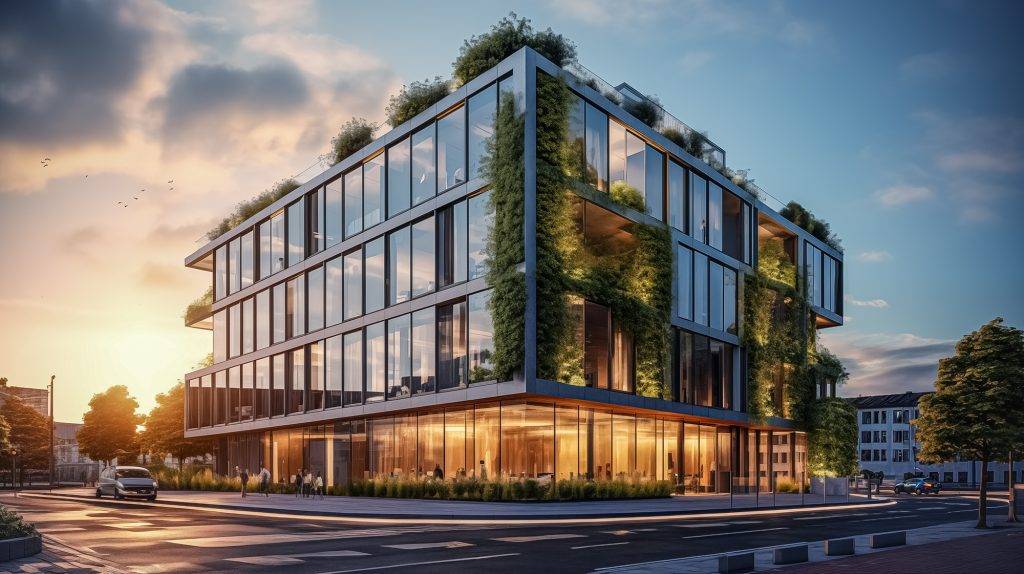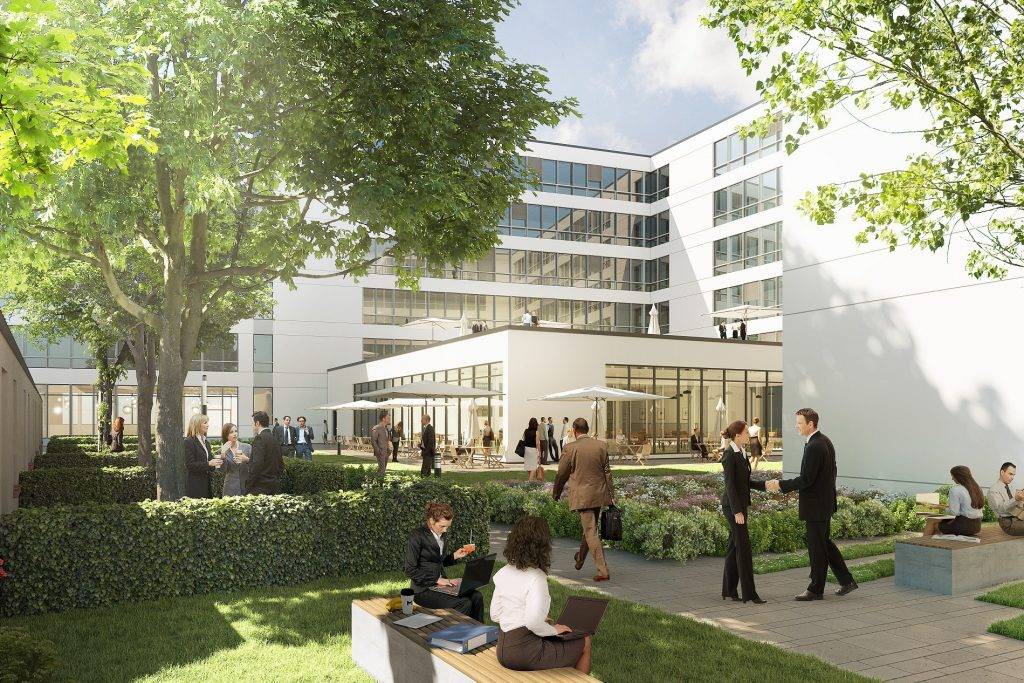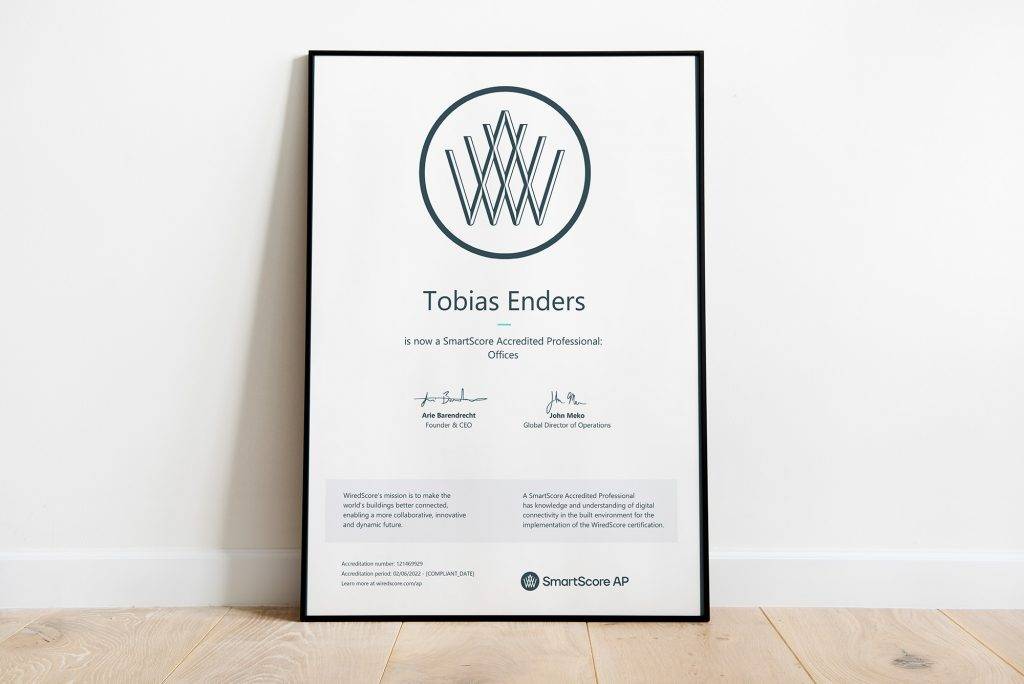
In a world where the impacts of climate change are becoming increasingly evident, the significance of sustainability is growing across all aspects of life – including the real estate industry and sustainable construction practices. More and more developers, facility managers, and investors are embracing green certifications and guidelines such as the ESG criteria (Environmental, Social, Governance) to make their properties more environmentally friendly while increasing their value. This article delves into the reasons behind this trend and explores the strategies to achieve these goals.
Inhalt:
- Understanding the problem: Why is green building so crucial?
- Modernization and digitalization of existing buildings
- Solutions for sustainable construction: ESG and other certifications
- Culture of use and modern technologies: Smart buildings and IoT
- The future of work: Cultural aspects, digitalization, and regulation
- Summary
Imagine a building that looks and functions beautifully and contributes to our planet’s well-being. A structure that consumes less energy generates less waste and creates a healthier and more pleasant environment for its occupants. Does it sound like a vision of the future? It is the reality for many modern buildings – and it could be the future of your structure, too.
Understanding the problem: Why is green building so crucial?
Global warming and climate change pose serious threats to our planet. According to the United Nations Environment Program, buildings are responsible for approximately 38% of global energy consumption and about one-third of global greenhouse gas emissions, as reported by State Of Green. Therefore, we must find ways to make buildings more sustainable and energy-efficient.
In addition to the ecological reasons, there are also economic arguments for green building. Studies have shown that green buildings have a higher value and are more attractive to tenants and buyers. Moreover, they can significantly save operating costs through reduced energy and water consumption.
Further data supports these findings. According to Building Design+Construction Magazine, more than 1,000 survey participants from 69 countries expected 14% savings in operating costs over five years for new green buildings and 13% savings over five years for green retrofits and renovations. Additionally, building owners report that new and renovated green buildings have an asset value of 7% higher than traditional buildings.

These findings show why industry experts predict that more than 60% of their projects will be built to green standards by 2018. They also support the idea that green leases increasingly appeal to tenants and investors willing to pay premiums for long-term benefits.
Furthermore, the German Sustainable Building Council (DGNB) reports in an article that sustainable building reduces operating costs, roughly equivalent to construction costs over the lifespan of buildings. This enhances attractiveness and increases demand from investors, tenants, and customers. Future-proof buildings also ensure long-term value stability. Sustainability pays off in more ways than one.
Modernization and digitalization of existing buildings
It is crucial to recognize that most buildings in the future will not be new constructions but existing ones. Therefore, it is essential to focus on sustainable new buildings and developing strategies for modernizing and digitizing existing buildings. Digitalization can play a pivotal role in improving existing buildings’ energy efficiency and sustainability. For instance, smart building management systems can optimize energy consumption by automatically regulating heating, lighting, and ventilation.
Likewise, IoT sensors can collect and analyze data to further optimize building operations and achieve energy savings. Moreover, modernization measures such as enhancing building envelopes, installing energy-efficient systems, and utilizing renewable energy sources can help reduce energy consumption and improve the sustainability of existing buildings. Hence, modernizing and digitizing existing buildings represent a crucial strategy for reducing the building sector’s environmental impact and positively contributing to climate protection.
Solutions for sustainable construction: ESG and other certifications
ESG criteria and similar certifications provide a framework for sustainable building. They encompass ecological aspects such as energy efficiency and the use of renewable energy and social and governance-related factors.
For instance, for a building to attain “green” certification, it must adhere to specific standards concerning energy consumption, water usage, waste management, and other environmental considerations. Moreover, social aspects like accessibility for individuals with disabilities or the creation of communal spaces can also be considered.
LEED certifications
The LEED (Leadership in Energy and Environmental Design) certification is an internationally recognized seal for sustainable construction. Developed by the U.S. Green Building Council, it is a benchmark for the design, construction, and operation phases of new buildings, existing structures, interiors, and neighborhoods. LEED-certified buildings are renowned for their energy efficiency, water conservation, reduced CO2 emissions, improved indoor air quality, and better utilization of natural resources.
To achieve LEED certification, a project must meet predefined criteria and undergo an assessment process conducted by independent third parties. The certification process involves project registration, documentation of sustainable strategies and technologies employed, and ultimately, review and certification by the U.S. Green Building Council.
BREEAM certifications
The BREEAM (Building Research Establishment Environmental Assessment Method) certification is a recognized symbol of sustainable construction. Developed in the UK, it holds global recognition. BREEAM evaluates buildings based on various aspects such as energy efficiency, water management, health and well-being, pollution, transportation, materials, waste, ecology, and management processes.
To obtain BREEAM certification, developers must meet specific requirements and undergo an assessment process conducted by independent accredited BREEAM assessors. The BREEAM certification process includes project registration, pre-assessment, evidence collection, and final certification by the Building Research Establishment (BRE).
DGNB certifications
The DGNB (German Sustainable Building Council) certification is a prestigious seal for sustainable construction developed in Germany. It assesses buildings based on various criteria, including ecological, economic, sociocultural, and functional aspects, technology, processes, and location. This certification places a particular emphasis on the entire lifecycle of the building.
To obtain a DGNB certification, a building must meet specific requirements and undergo an evaluation process conducted by independent DGNB auditors. The process includes project registration, evidence collection, on-site inspection, and a final assessment. Depending on the evaluation result, the building can be awarded a DGNB certificate in bronze, silver, gold, or platinum – even outside Germany.
SmartScore and WiredScore certifications
SmartScore and WiredScore are certifications that assess buildings’ technological infrastructure and intelligence. The SmartScore certification represents a global standard that measures how well a building utilizes technology to meet the needs of its users, improve operational efficiency, and achieve sustainability goals. To obtain a SmartScore certification, a building must fulfill various requirements related to technological integration, data capability, user experience, and sustainability. The certification process involves a thorough evaluation by independent experts and collecting of supporting evidence.

The WiredScore certification, on the other hand, evaluates the digital connectivity of a building. It ensures that businesses in a building have access to the best available internet services and that the building can keep up with future technological advancements. To obtain the WiredScore certification, a building must undergo a detailed assessment process that analyzes the structure and management of the building’s digital infrastructure.
Both certifications ensure a building is technologically advanced, user-friendly, and future-proof. Each certification process ensures that the buildings meet the requirements and have various stages of accreditation based on the achieved results.
Culture of use and modern technologies: Smart buildings and IoT
One more crucial aspect of green building is the culture of utilization. Modern technologies like smart buildings and the Internet of Things (IoT) can play a pivotal role here. They enable the efficient utilization of buildings while enhancing user comfort and satisfaction.
Smart buildings employ sensors, actuators, and microchips to collect and analyze data on building usage. This data can then be leveraged to optimize building operations—for instance, by adjusting heating and cooling based on actual use, automatically turning off lights in unoccupied rooms, or optimizing cleaning and maintenance schedules.
Furthermore, smart buildings can contribute to improving user health and well-being. They can monitor and enhance air quality, maximize natural lighting, and ensure pleasant acoustics, among other benefits.
The future of work: Cultural aspects, digitalization, and regulation
The way we work is rapidly evolving. Flexible work models, remote work, and co-working spaces are gaining popularity. These trends are also influencing the design and use of buildings. For instance, flexible work models require more adaptable office spaces. Instead of assigning each employee a fixed desk, companies need more open and collaborative areas that can be reconfigured. These spaces should encourage communication and teamwork while providing enough privacy for focused work.
Digitalization is also increasingly important in the workplace and building design. Digital tools and platforms enable more efficient collaboration within a single location and across multiple sites. However, they also require the proper infrastructure, such as connectivity and data security. Regulatory measures and standards are driving the rise of green buildings and renovations. For example, the EU Taxonomy is a classification system that defines which economic activities can be considered environmentally friendly. It is becoming more influential in helping investors, companies, and individuals understand which activities substantially contribute to environmental protection.
The Taxonomy also incentivizes companies to invest in green buildings by establishing clear criteria for environmentally friendly investments. By investing in green buildings, companies can gain a competitive advantage and increase their appeal to investors and customers. Furthermore, environmental accountability is becoming a requirement for businesses. Many countries and regions, including the EU, are introducing laws that compel companies to disclose their environmental impacts. This pressures companies to adopt more sustainable practices, including investing in green buildings. These regulatory measures and standards, coupled with the potential cost savings and other benefits of green buildings, make them an increasingly attractive option for companies and investors.
Summary
In summary, it can be observed that green buildings are gaining increasing importance from both economic and ecological perspectives. Various certifications, such as BREEAM, DGNB, SmartScore, and WiredScore, serve as valuable tools for evaluating and enhancing building sustainability, efficiency, and technological integration. Modern technologies like smart buildings and IoT contribute to optimizing buildings by reducing energy consumption and improving user experience.
Avoiding the formation of stranded assets in real estate – but how? Investing in green buildings makes economic sense as it leads to long-term cost savings through energy efficiency and contributes to increasing property value. Moreover, they can enhance user satisfaction and productivity, thereby contributing to the competitiveness of businesses. Green buildings are also crucial from an environmental standpoint as they help reduce the CO2 footprint and minimize the consumption of natural resources.
When comparing retrofitting and new construction, it is essential to consider that both approaches have pros and cons. Retrofitting is often more cost-effective and less resource-intensive than new construction, but it can also present challenges regarding integrating modern technologies and compliance with current standards. On the other hand, new construction offers the opportunity to design and build a structure from the ground up, incorporating the latest standards and technologies.
In conclusion, it can be said that green buildings, whether achieved through retrofitting or new construction, hold great significance for investors and the environment alike. They are fundamental to a sustainable and future-oriented construction and real estate industry.